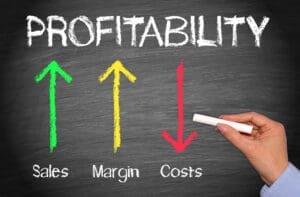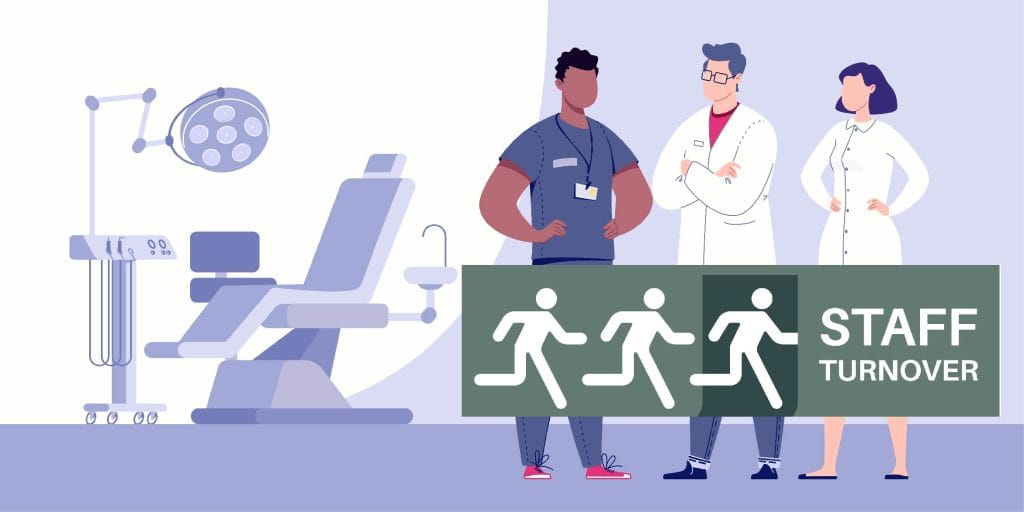It’s something that every business owner chases, yet what it is and how to calculate it properly is poorly understood, especially in owner-operated businesses like a dental practice.
To wit: If I were to ask you what your average monthly profit margin is, would you know it off the top of your head? Or would you need to grab a profit and loss statement? And even then, does that statement account for the compensation you’re giving yourself as the owner-doctor? And is that compensation at a standard market rate? And note, you’ll see why this last question is extremely important later in the article.
What is Profit?
Let’s start simple with a basic definition of profit.
Profit is the amount of money left in a business when revenue exceeds expenditures.
If your practice generates $1 million in revenue and your expenses total $750,000, then you have $250,000 in profit. This simple equation can be applied to your practice as a whole or even down to individual procedures.
For example, let’s say you charge $1,300 for a crown. If you break down the costs, including labor, materials, and lab fees, and find that your expenses amount to $386, then your profit on that crown is $914. No matter how you do it, the basic formula remains the same: Income minus expenses equals profit.
The Confusion in Dental Practice Profitability
Now, here’s where things get confusing, particularly for an owner-operated dental practice – or any owner operated business.
 Profit is supposed to be what is “left over” after expenses. It’s how a business OWNER is compensated. In addition to being the owner of your practice, you’re also, most likely, the primary producer or doctor.
Profit is supposed to be what is “left over” after expenses. It’s how a business OWNER is compensated. In addition to being the owner of your practice, you’re also, most likely, the primary producer or doctor.
These (owner and doctor) are distinctly different “hats” with different expected outcomes and most importantly different compensation methods. Think about it for a second – if you were to replace yourself as the doctor, while remaining the “owner” of the practice – how would that affect your compensation?
Well, assuming you’re the average practice and that you’re producing most of the revenues along with performing the more involved procedures, you’d have to pay market rates for this replacement doctor. And this does not even account for the fact that if you replaced yourself fully as the doctor, you would of course expect this replacement doctor (associate) to handle diagnosis and case presentations.
So, what would we pay for this replacement doctor? On average about 30% of production. Now this may be paid through any combination of pay plans (i.e. per diem plus incentive, etc.) but the 30% number still holds in the long run. And sure, it could be more (or less) depending on where you practice and the situation, but again, the 30% number is fairly safe.
If we understand this, and we understand that an “owner’s” compensation is PROFIT, we start to see where things go wrong.
Case in point. Doctor A has a practice with a 60% overhead. He produces $100,000 a month. That 60% overhead does NOT include his salary as he is the “owner.” He pays himself a nominal salary of $200,000 a year – based on his overhead at home and what his accountant told him to do.
So, his monthly overhead without his pay included looks like this:
Collections $100,000
Overhead* $ 60,000 (60%)
Profit $ 40,000 (40%)
Alright – not bad. He’s “netting” 40%. It could be better – but not bad.
Now, we add his salary, which is $200,000 a year or $16,667 a month. And it looks like this:
Overhead* $ 60,000 (60%)
Dr. Salary $ 16,667
Profit $ 23,333 (23.3%)
Now – we’re still at 40% potential compensation (between salary and profit) so not all that bad. But let’s look at something for a minute. The doctor is paying themselves $200,000 a year or $16,667 a month as a “salary.” This amount isn’t really based on anything other than, that’s what the doctor needed, and what the practice could pay. If we were to replace Doctor A with an associate (who produced the same or similar amount), how would this look?
Well, Doctor A averages about $80,000 a month in production, with Hygiene picking up the other $20,000 making the average for the practice overall $100,000 per month. If we were to pay an associate to produce this $80,000, how much would it cost us? Well, using the 30% model, it would look like this:
$80,000 X 30% = $24,000 a month or $288,000 a year.
So, that $200,000 salary Doctor is paying himself is well below market value. By close to 45%!
But is this practice healthy? Well, let’s look at this overhead again with the associate in place of Doctor A.
Collections $100,000
Overhead* $ 60,000 (60%)
Dr. Salary $ 24,000** (24%)
Profit $ 16,000 (16%)
So, if Doctor A were to replace himself, the practice’s profit would be about 16%. Which without jumping into the “accounting” aspect of all this, would be his PROFIT as an owner.
So, again, would this 16% be healthy? Well, no, it wouldn’t.
What Should Your Profit Margin Be?
 So, what should your profit margin be? Ideally, you should aim for a profit margin of around 30%. This means your total expenses should not exceed 70% of your income. If your practice relies heavily on associate doctors, your profit margin should be at least 20% and ideally closer to 25%+. This means in our example above, Doctor A was running about 4% below what we’d consider to be the minimum.,
So, what should your profit margin be? Ideally, you should aim for a profit margin of around 30%. This means your total expenses should not exceed 70% of your income. If your practice relies heavily on associate doctors, your profit margin should be at least 20% and ideally closer to 25%+. This means in our example above, Doctor A was running about 4% below what we’d consider to be the minimum.,
Now, this 20% number is based on a doctor replacing themselves completely. Obviously if Doctor A were still chairside and had one or more associates the margin would be substantially higher (30-40%)– again depending on who was doing what.
But if you were to run the numbers for your practice using the example above and the “margin” is less than 20%, you may have some work to do to optimize your practice’s profitability.
And look, let’s not confuse this calculation with what your P&L and tax return say. That’s an accounting matter. What I’m trying to do with this is to have you separate your owner and doctor “hats” and examine whether your practice is in fact financially healthy.
Strategies for Improving Profitability
If you found yourself below that 20% floor, what’s next? Well, I’d definitely advise that you reach out to us for a full analysis of your business to determine your next move. That said, there are three primary ways to enhance your practice’s profitability:
- Monitor and Reduce Expenses
- Increase Income
- Optimize Practice Structure
And these may be done in a certain sequence or simultaneously. Depends on the situation. Let’s have a look at each.
1. Monitor and Reduce Expenses
Reducing expenses (spending less) is a no-brainer if you want to increase profitability. But how do you know how much you should be spending on different aspects of your practice, such as marketing, rent, or staff salaries? This is where tools like the MGE Overhead Sheet come in handy. The Overhead Sheet allows you to compare your expenses against industry benchmarks to see where you might be overspending.
Efficiency and productivity are key when it comes to reducing expenses. For example, if your hygienist has a lot of open slots in their schedule, you’re still paying them for their time, even if they’re not generating revenue. Similarly, if your scheduler is not doing a good job and your schedule is full of openings, you’re paying them the same amount as you would a scheduler who keeps the schedule full. By maximizing efficiency and eliminating waste, you can reduce expenses and increase your profitability.
2. Increase Income
 Often overlooked as an immediate action, increasing income is the fastest (and most robust) solution to seeing a profitability increase. In a dental practice, there are three primary ways to do this:
Often overlooked as an immediate action, increasing income is the fastest (and most robust) solution to seeing a profitability increase. In a dental practice, there are three primary ways to do this:
– Increase Case Acceptance: If you’re not particularly skilled at presenting cases to patients, you may only be closing 20-30% of the cases you present. For example, if you present a treatment plan for six crowns, but the patient only agrees to two because that’s what insurance covers, you’ve left a lot of potential revenue (and potentially reduced patient health), on the table. By improving your communication skills and effectively presenting the value of the treatment to the patient, you could close all six crowns, significantly increasing your revenue. And now my shameless plug. We teach you exactly how to do this at the MGE Communication and Sales Seminars. The average client increases in the first year of doing them is $288,000! Click here to find out more.
– Adjust Fees: Many practices are charging too little for their services. This often happens because fees were set when the practice was first established and haven’t been updated to reflect current market rates. I’ve seen practices where the fee structure is in the 30th or 40th percentile, meaning 60-70% of other practices in the same area are charging more. It’s essential to regularly review and adjust your fees to ensure they are competitive and reflective of the value you provide.
– Evaluate Participation in Managed Care Plans: If you participate in managed care plans, you may be charging less than what your services are worth, and there’s often little you can do about it. In many cases, the best solution is to gradually get out of these plans. With inflation exceeding 21% from March 2020 to now, staying in plans that don’t pay well can severely impact your profitability. We can help you with this as well with our free Fees and Plans Analysis (sorry second shameless plug).
3. Optimize Practice Structure
The third way to improve profitability is to optimize how your practice is structured. This can involve a variety of factors, but I’ll focus on two that I see frequently:
– Clear Aligner Cases: Clear aligners are a popular service, but they come with high lab fees that can eat into your profitability. For example, if you charge $5,000 for a clear aligner case and the lab fee is $1,800, your margin is only $3,200, or 64%. Compare that to a crown where you might charge $1,200 with a lab fee of $150, giving you a margin of $1,050 or 87.5%. If a significant portion of your production comes from clear aligners, your overall profitability can take a hit. While clear aligners should be offered, they shouldn’t be the main focus of your practice. Obviously, you as the clinician have to decide what’s best for your patients, but in my experience if you’re running the average general dental practice, and ensuring your patients are getting what they need, the clear aligner percentage tends to stay manageable and just a modest part of the blend of practice procedures.
– Hygiene Department Productivity: Another key area to consider is the productivity of your hygiene department. Ideally, hygiene should account for at least 30% of your practice’s total revenue. If it’s less than that, the doctor’s compensation as a percentage of overall revenue can become too high, reducing profitability. For example, if your practice generates $150,000 a month and hygiene accounts for $45,000 of that, the doctor’s compensation should be 21% of total revenue (i.e. 21% of $150,000). But if hygiene only accounts for $25,000, the doctor’s compensation could be as high as 25%, leaving less profit at the end of the month.
Conclusion: Think Like an Owner, Not Just a Doctor
Understanding and accurately calculating profitability is crucial for the long-term health and success of your dental practice. By separating your roles as owner and doctor, monitoring and reducing expenses, increasing income, and optimizing your practice structure, you can ensure that your business remains profitable and sustainable.
Remember, as the owner, your compensation should come from profit. The salary you pay yourself as the doctor is just that – doctor pay. But beyond all of this, a well run practice will be PROFITABLE. If your practice isn’t as profitable as it should be, it’s time to take a closer look at your numbers and make the necessary adjustments.





No Comments
Be the first to start a conversation